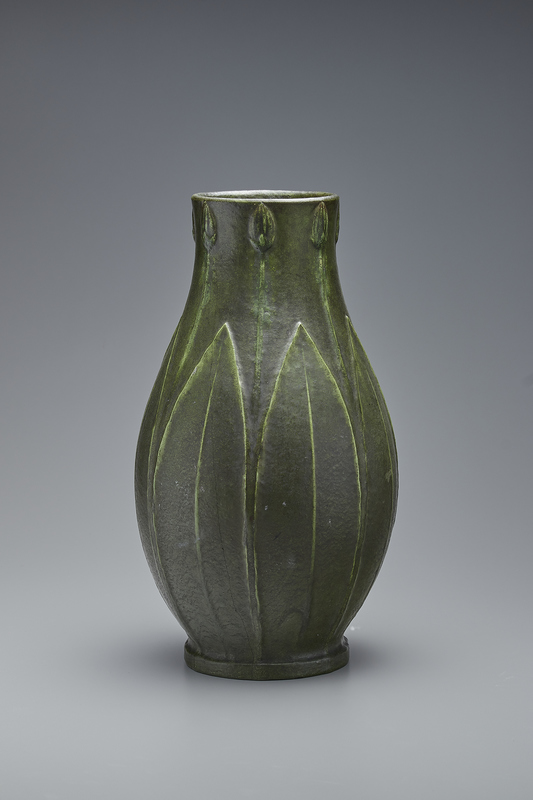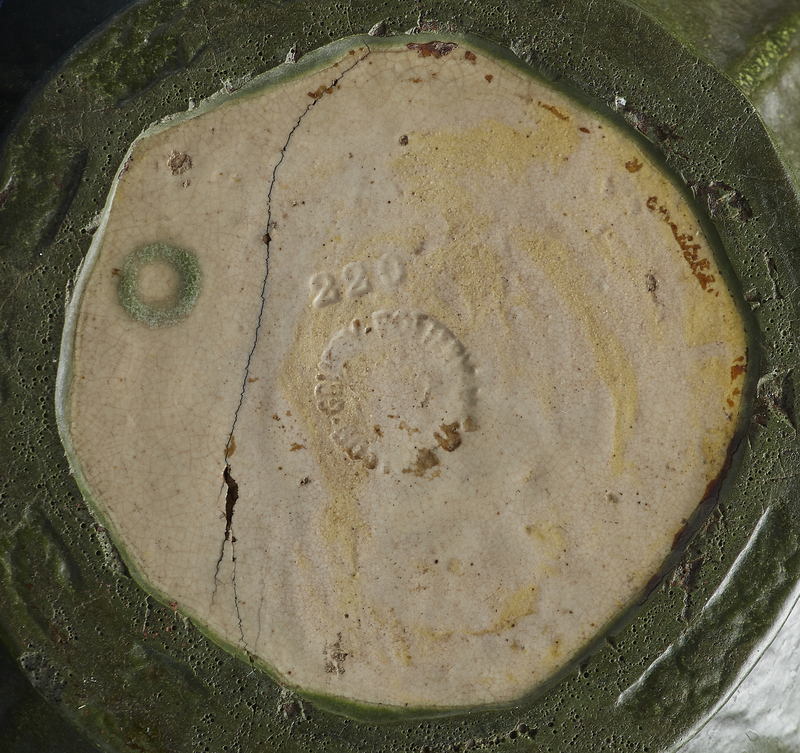Lamp Base or Vase (shape no. 220)
Item
Title
Lamp Base or Vase (shape no. 220)
Creator
Grueby Pottery Co.
Date
1900-02 (probably)
Dimensions
15 3/8 inches (h) (base)
30 1/4 inches (h) (assembled)
30 1/4 inches (h) (assembled)
Medium
Glazed earthenware
Object No.
2007.1a-c
Credit line
Gift of Barbara and Henry Fuldner
Marks
Impressed circular mark: "GRUEBY POTTERY / BOSTON USA," "220," and a green circle.
Description
The ubiquitous presence of alternating buds and leaves in Grueby’s design repertoire complicates attribution to a specific designer, but several factors argue for an early execution of this vase, which would place it firmly during Kendrick’s tenure. Formally, the shape and design of the vase is indebted to a smaller version introduced from 1898-1900, with the most notable difference being the sharply pointed leaves in the larger version. If the proportions and the buds conform strongly to the earlier precedent, the pointed leaves also appear on a number of early designs attributed to or associated with Kendrick. In addition, the mark of the glazer—an “O”—has been documented on wares dating from this earliest period. The rather high design number and late pottery stamp suggest the piece was executed after 1900.
The manner in which many Grueby vessels bear similar elements points to a design process that stressed variations on a theme, rather than beginning anew with each vessel. Because this persisted under a number of different head designers, it strengthens the notion that in addition to his development of glazes, William H. Grueby played a crucial role in determining the firm’s aesthetic throughout its history. As an author in Keramic Studio informed readers: “The Grueby Shapes are simple. It is evident that a man of artistic tastes directs the form and decoration… Whatever the ceramic reputation of Grueby may be in the coming years it must always have the credit of having set the standard of taste for quiet things and of having had a great educational effect upon the American Public.”
Further suggesting an early date for this lamp is that Stickley used an identical model in a number of advertising vignettes from the 1902 Retail Plates onward. While the shade is a different model than that which appears in the November 1911 article on The Log House, it appears that the earlier shade was repurposed and placed on a smaller Rookwood lamp that appears on the hexagonal table in the same article. Additionally, this change may explain the notation in Stickley’s personal account on February 10, 1911 “Shade on G. S. Lamp” with the relatively small charge of $1.08.
The manner in which many Grueby vessels bear similar elements points to a design process that stressed variations on a theme, rather than beginning anew with each vessel. Because this persisted under a number of different head designers, it strengthens the notion that in addition to his development of glazes, William H. Grueby played a crucial role in determining the firm’s aesthetic throughout its history. As an author in Keramic Studio informed readers: “The Grueby Shapes are simple. It is evident that a man of artistic tastes directs the form and decoration… Whatever the ceramic reputation of Grueby may be in the coming years it must always have the credit of having set the standard of taste for quiet things and of having had a great educational effect upon the American Public.”
Further suggesting an early date for this lamp is that Stickley used an identical model in a number of advertising vignettes from the 1902 Retail Plates onward. While the shade is a different model than that which appears in the November 1911 article on The Log House, it appears that the earlier shade was repurposed and placed on a smaller Rookwood lamp that appears on the hexagonal table in the same article. Additionally, this change may explain the notation in Stickley’s personal account on February 10, 1911 “Shade on G. S. Lamp” with the relatively small charge of $1.08.
Provenance
Gustav Stickley (probably by 1902), by descent to Barbara Stickley Wiles (1942), by descent to her grand-daughter Barbara Fuldner (1980).


